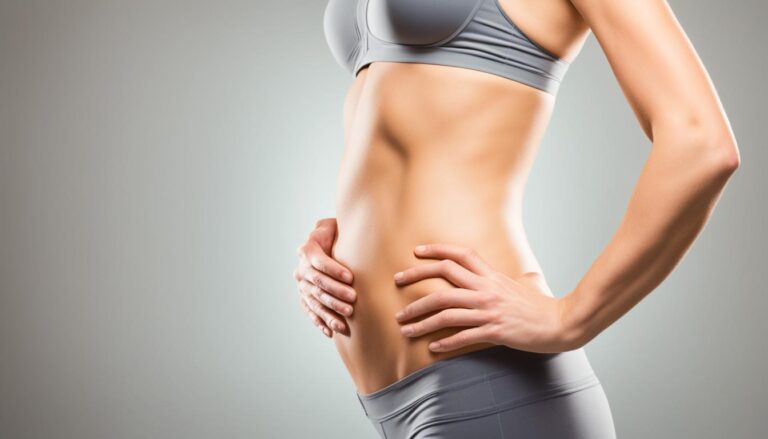How can I make my stomach look flat?
Are you tired of feeling self-conscious about your stomach? Do you dream of flaunting a flat midsection? You’re not alone. Having a flat stomach is a common goal for many people, but it can be challenging to achieve. The good news is that with the right strategies and lifestyle changes, you can work towards making your stomach look flat and feel more confident in your own skin.
When it comes to achieving a flat stomach, there’s more to it than just weight loss. Factors such as fat distribution, bloating, and muscle tone all play a role in the appearance of your midsection. By addressing these factors through diet and exercise, you can take steps towards achieving the flat stomach you desire.
In this article, we will explore various tips and strategies that can help you reduce belly bloat, tone your stomach muscles, and slim down your midsection. From diet recommendations to stomach-slimming exercises, we’ve got you covered. Are you ready to discover the secrets to a flatter stomach? Let’s dive in!
Key Takeaways:
- Achieving a flat stomach involves more than just weight loss.
- Fat distribution, bloating, and muscle tone impact the appearance of your stomach.
- By addressing these factors through diet and exercise, you can work towards a flatter stomach.
- This article will provide tips and strategies for reducing belly bloat, toning your muscles, and slimming down your midsection.
- Are you ready to learn how to make your stomach look flat? Keep reading!
Factors Affecting Stomach Shape
Fat distribution, bloating, and muscle tone are key factors that contribute to the appearance of your stomach. Understanding these factors can help you work towards achieving a flatter stomach and improved overall body confidence.
Fat distribution: It’s important to recognize that fat distribution varies among individuals. Some people may be more prone to carrying excess weight in their abdominal area, leading to a rounder stomach. However, overall weight loss can help slim down the midsection and reduce belly fat.
Bloating: Bloating can make your stomach appear larger and distended, even if you don’t have excess fat. Factors such as certain foods, digestive issues, or hormonal fluctuations can contribute to bloating. By identifying and addressing the root cause of bloating, you can improve the appearance of your stomach.
Muscle tone: Toning the muscles in your abdominal area can help define the appearance of your stomach. Engaging in exercises that target the core, such as planks, crunches, and Russian twists, can strengthen the muscles and create a more sculpted look. Additionally, post-pregnancy, stretched stomach muscles may contribute to a rounder stomach. Incorporating exercises to restore muscle tone can help you achieve a flatter stomach.
By understanding and addressing these factors affecting stomach shape, you can work towards achieving a flat stomach appearance and improved confidence in your body.
Flat Stomach Tips: Effective Solutions for Improving Stomach Shape
Achieving a flat stomach can be a challenging goal, but incorporating these tips into your daily routine can help you get closer to your desired shape. Remember, there is no one-size-fits-all solution, so it’s important to find what works best for you.
Eat Frequent Small Meals
Instead of large meals, opt for frequent small meals throughout the day. This can help keep your metabolism active and prevent overeating later on.
Stay Hydrated
Drinking an adequate amount of water can prevent water retention and reduce bloating. Aim to drink at least 8 cups (64 ounces) of water per day.
Consider Macros
Macronutrients, such as carbohydrates, proteins, and fats, play a crucial role in your diet. Focus on decreasing your carbohydrate intake and increasing your protein consumption to support a flat stomach.
Choose the Right Carbohydrates
Not all carbohydrates are created equal. Opt for complex carbohydrates, such as whole grains, fruits, and vegetables, which provide more fiber and promote satiety.
Increase Fiber Intake
Fiber-rich foods can help you feel full for longer and support healthy digestion. Add sources of fiber, like beans, lentils, whole grains, and vegetables, to your daily meals.
Eat More Lean Protein
Lean sources of protein, such as chicken, turkey, fish, tofu, and legumes, can help build and maintain muscle mass while keeping you satisfied.
Use Quality Fats
Include healthy fats in your diet, such as avocados, nuts, seeds, and olive oil. These fats can provide essential nutrients and promote feelings of fullness.
Avoid High-Calorie Drinks
Sugary beverages, like soda and fruit juices, can quickly increase your calorie intake. Opt for water, unsweetened tea, or infused water instead.
Track Food and Drinks
Keeping a food journal or using a mobile app can help you monitor your food and drink consumption. This awareness can facilitate healthier choices and hold you accountable.
Identify Food Sensitivities
Some individuals may have food sensitivities that contribute to bloating. Pay attention to how your body reacts to certain foods and consider eliminating or reducing them from your diet.
Prioritize Cardio
Incorporate cardiovascular exercises into your routine to burn calories and promote overall fat loss. Aim for at least 150 minutes of moderate-intensity cardio per week.
Increase Movement
Look for opportunities to increase movement throughout the day. Take the stairs instead of the elevator, park farther away from your destination, or go for a walk during your lunch break.
By following these flat stomach tips and making small, sustainable changes to your lifestyle, you can work towards achieving a flatter stomach and improving your overall health.
Cut Calories, but not Too Much
To achieve weight loss, one of the key strategies is to monitor calorie intake. By reducing your daily calorie consumption, you can create a calorie deficit that leads to a safe and sustainable weight loss of 1-2 pounds per week. A reduction of 500-750 calories per day is generally recommended for this purpose.
However, it is essential to find the right balance when cutting calories. Extreme calorie restriction can have negative effects on your health and hinder your weight loss progress. Restricting calories too much or for extended periods of time can lead to the following:
- Lowered metabolic rate: Consuming too few calories can slow down your metabolic rate, making it harder for your body to burn calories efficiently. This can result in weight loss plateaus and make it more challenging to continue losing weight.
- Loss of lean body mass: Severely restricting calories can cause your body to lose muscle mass along with fat. Losing lean body mass can negatively impact your overall strength, body composition, and metabolic rate.
- Negative health effects: Extremely low-calorie diets can have various negative health effects, such as fatigue, headaches, irritability, nutrient deficiencies, and a weakened immune system.
It’s important to prioritize your health and well-being when pursuing weight loss. Instead of severely cutting calories, focus on creating a moderate calorie deficit that supports your goals while still providing your body with the necessary nutrients it needs to function optimally. Consulting with a healthcare professional or registered dietitian can be helpful to determine the appropriate calorie reduction for your individual needs.
Remember, sustainable weight loss is a gradual process that requires a combination of healthy eating, regular physical activity, and lifestyle changes. By making gradual and sustainable changes to your calorie intake, you can achieve your weight loss goals while maintaining your metabolic rate and preserving lean body mass.
Eat More Fiber, Especially Soluble Fiber
Consuming more fiber, especially soluble fiber, can have numerous benefits for your overall health and well-being. Soluble fiber is a type of fiber that dissolves in water, forming a gel-like substance in your gut. This helps create a feeling of fullness and can aid in weight management.
One of the advantages of soluble fiber is its ability to slow down stomach emptying. This means that the food stays in your stomach for a longer time, leading to increased fullness and reducing the likelihood of overeating between meals. By incorporating foods high in soluble fiber into your diet, you can help control your appetite and prevent mindless snacking.
Another benefit of soluble fiber is its effect on calorie absorption. When you consume soluble fiber, it can bind to certain nutrients, such as fats and sugars, in your digestive system. This may lead to reduced calorie absorption from these foods, which can be helpful for weight management and maintaining a healthy calorie balance.
Research has also shown that a higher intake of soluble fiber may be associated with a reduction in visceral fat. Visceral fat is the fat that wraps around your internal organs and is linked to various chronic health conditions, including heart disease and type 2 diabetes. By consuming more soluble fiber, you may be able to reduce your visceral fat levels and improve your overall health.
So, where can you find soluble fiber? Fortunately, many common foods are rich in this beneficial type of fiber. Some examples include:
- Fruits (such as apples, oranges, and berries)
- Oats and oat bran
- Legumes (such as beans, lentils, and chickpeas)
- Certain vegetables (such as Brussels sprouts, carrots, and sweet potatoes)
By incorporating these fiber-rich foods into your diet, you can increase your soluble fiber intake and enjoy the numerous health benefits it provides.
| Foods High in Soluble Fiber | Soluble Fiber Content per Serving |
|---|---|
| Apple (with skin) | 4.4 grams |
| Oats (cooked) | 2 grams |
| Black beans (cooked) | 4.8 grams |
| Brussels sprouts (cooked) | 2 grams |
By making a conscious effort to eat more fiber, especially soluble fiber, you can enhance feelings of fullness, reduce calorie absorption, and potentially reduce visceral fat. Incorporate fiber-rich foods into your meals and snacks to reap the many health benefits of this essential nutrient.
Increase Your Intake of Probiotics
When it comes to weight management and reducing belly fat, probiotics can be a valuable tool. These beneficial bacteria can help shift the balance of your gut microbiome, potentially reducing the risk of weight gain and promoting a healthier body composition.
Specific strains of probiotics, such as Lactobacillus fermentum, Lactobacillus amylovorus, and Lactobacillus gasseri, have shown promise in targeting belly fat reduction, especially in individuals with obesity.
“Probiotics play a role in weight management by shifting the balance of gut flora and reducing the risk of weight gain.”
Incorporating probiotic-rich foods into your diet can help support a healthy gut and aid in weight management. Fermented foods like yogurt, kefir, kimchi, and pickles are excellent sources of probiotics. By including these foods in your meals, you can promote the growth of beneficial gut flora, which may contribute to reducing belly fat.
It’s important to note that probiotics should not be seen as a magical solution on their own. They work best when used in conjunction with a nutritious diet and regular exercise. Additionally, results may vary from person to person.
Probiotic Foods for a Healthier Gut
| Probiotic Food | Strains of Probiotics |
|---|---|
| Yogurt | Lactobacillus acidophilus, Bifidobacterium lactis |
| Kefir | Lactobacillus kefiri, Lactobacillus kefiranofaciens |
| Kimchi | Lactobacillus brevis, Lactobacillus plantarum |
| Pickles | Lactobacillus plantarum, Lactobacillus brevis |
Incorporating probiotic-rich foods into your diet can provide a range of health benefits beyond weight management. They can improve digestion, support immune function, and enhance overall gut health.
Image of Probiotic Foods

Remember, a holistic approach to weight management is key. By adding probiotic-rich foods to your diet, you can support the health of your gut microbiome and potentially reduce belly fat. Combine this with regular exercise and a well-balanced diet for optimal results.
Add More Cardio to Your Routine
Cardiovascular exercises are an effective way to burn calories, improve heart health, strengthen your midsection, and reduce belly fat. Adding regular cardio workouts to your routine can contribute to overall fat loss and help you achieve a flatter stomach.
Aim for 150–300 minutes of moderate to high-intensity aerobic exercise per week. Choose activities that increase your heart rate and engage your core muscles such as running, brisk walking, biking, or swimming. These exercises not only burn calories but also strengthen the muscles in your midsection, including the abdominal muscles.
Regular cardio workouts can help trim excess belly fat by increasing calorie burn and promoting fat loss throughout your body. Consistency is key, so find activities you enjoy and make them a part of your weekly routine.
By incorporating cardiovascular exercises into your fitness regimen, you can boost calorie burning, strengthen your midsection, and work towards reducing belly fat.
| Activity | Calories Burned (per hour) |
|---|---|
| Running (8-minute mile) | 606 |
| Brisk Walking (3.5 mph) | 314 |
| Cycling (12-14 mph) | 622 |
| Swimming (moderate intensity) | 423 |
Note: Calorie burn varies depending on factors such as body weight and intensity level.
Try Protein Shakes
Protein shakes are a simple and convenient way to increase your protein intake, which can have several benefits for your body. Not only can protein shakes help boost your metabolism, but they may also aid in reducing appetite and maintaining lean body mass. Research suggests that a higher protein intake, when combined with a lower-calorie diet, can even assist in reducing visceral fat, which is the fat that surrounds your internal organs and is associated with various health risks.
For optimal results, make sure to choose protein shakes that are low in added sugars and high in quality protein. Whey protein, for example, is a popular choice due to its high biological value and ability to be quickly absorbed by the body. Additionally, consider adding some fiber-rich ingredients to your protein shake, such as spinach, kale, or berries. This will not only provide additional nutrients but also help promote satiety and support healthy digestion.

Incorporating protein shakes into your daily routine can be an effective strategy for supporting your weight management goals. Whether you enjoy them as a post-workout snack or a meal replacement, protein shakes offer a convenient and nutritious way to fuel your body and support a leaner, healthier physique.
Eat Foods Rich in Monounsaturated Fatty Acids
Incorporating foods rich in monounsaturated fatty acids into your diet can support body weight reduction and belly fat reduction. Monounsaturated fatty acids, also known as healthy fats, can be found in various delicious food sources, including:
- Olive oil
- Avocados
- Nuts (such as almonds, peanuts, and cashews)
- Seeds (such as sunflower seeds and sesame seeds)
Diets that are abundant in monounsaturated fatty acids have been linked to decreased body weight. In particular, the Mediterranean diet, which emphasizes these healthy fats, has been associated with a reduced risk of weight gain and a decrease in belly fat. By incorporating these foods into your eating plan, you can support your weight management goals and promote a flatter stomach.
Did You Know?
Monounsaturated fatty acids can provide numerous health benefits beyond body weight reduction. They are also beneficial for heart health, as they can help lower bad cholesterol levels. So, incorporate these healthy fats into your diet for a healthier you.
Limit Your Intake of Refined Carbs
When it comes to achieving your weight loss goals and reducing belly fat, one simple dietary change you can make is to limit your intake of refined carbohydrates. Refined carbs, such as white bread and white pasta, have gone through a process that removes the bran and germ, stripping away important nutrients and fiber. This processing also makes them quickly digested and absorbed by the body, leading to spikes in blood sugar levels and potential weight gain.
Instead of relying on refined carbs, consider incorporating whole grains into your diet. Whole grains, like quinoa, brown rice, and whole wheat bread, are nutrient-dense and provide essential fiber that can help support healthy digestion and promote a feeling of fullness. Studies have shown that including more whole grains in your diet is associated with decreased body weight and a reduction in belly fat.
Not sure how to make the switch? Here are some simple swaps you can make:
- Replace white bread with whole wheat or whole grain bread.
- Choose brown rice or quinoa instead of white rice.
- Opt for whole grain pasta instead of the traditional white pasta.
- Experiment with alternative grains like barley, buckwheat, or farro.
By making these small changes, you can enjoy the benefits of whole grains while promoting body weight reduction and belly fat reduction. Remember, it’s not about eliminating carbs altogether, but rather choosing the right kind of carbs that nourish your body and support your weight loss goals.
For a better understanding, here’s a visual representation of refined carbs vs. whole grains:
| Refined Carbs | Whole Grains |
|---|---|
| White bread | Whole wheat bread |
| White pasta | Whole grain pasta |
| White rice | Brown rice |

Try Resistance Training
Resistance training, such as weightlifting and bodyweight exercises, is an excellent addition to your fitness routine when aiming to achieve a flatter stomach. Not only does resistance training help preserve muscle mass, but it also plays a crucial role in maintaining metabolic rate during weight loss.
One of the key benefits of resistance training is its ability to contribute to a significant reduction in overall body fat, including the stubborn visceral fat that surrounds your organs. By incorporating resistance training into your exercise regimen, you can build lean muscle, burn more calories, and ultimately achieve your goals of a flatter stomach.
Combining resistance training with cardiovascular exercise has been proven effective in reducing body fat. Engaging in activities like weightlifting, squats, lunges, and push-ups challenges your muscles, boosts your metabolism, and aids in the reduction of total body fat.
Resistance training provides multiple benefits that go beyond just the appearance of a flatter stomach. By building muscle, you enhance your body’s ability to burn calories, even at rest. This can contribute to long-term weight management and overall health improvement.
So, if you’re looking to attain a toned midsection and reduce body fat, make sure to incorporate resistance training into your fitness routine. Aim for at least two to three sessions per week, focusing on different muscle groups. Combine it with cardiovascular exercises to maximize your results and achieve a flatter stomach.
Remember, achieving a flat stomach is a holistic process, and resistance training is an essential component of a well-rounded fitness routine.
Conclusion
In summary, achieving a flat stomach requires a holistic approach that combines various strategies such as diet, exercise, and lifestyle changes. It is not solely about weight loss but also addressing factors such as fat distribution, bloating, and muscle tone.
By following the tips and recommendations outlined in this article, you can work towards achieving a flatter stomach and improving your overall health. Incorporating frequent small meals, staying hydrated, choosing the right carbohydrates, increasing fiber intake, and eating more lean protein are key dietary considerations.
Additionally, adding cardio exercises, resistance training, and increasing overall movement can contribute to burning calories, strengthening the midsection, and reducing belly fat. Finally, considering the use of protein shakes, incorporating foods rich in monounsaturated fatty acids, and limiting refined carb intake can further support your efforts.
Remember, achieving a flat stomach is a journey that requires consistency and patience. Embracing a holistic approach that encompasses various factors will yield the best results. By adopting these strategies, you can not only achieve a flatter stomach but also improve your overall well-being.







